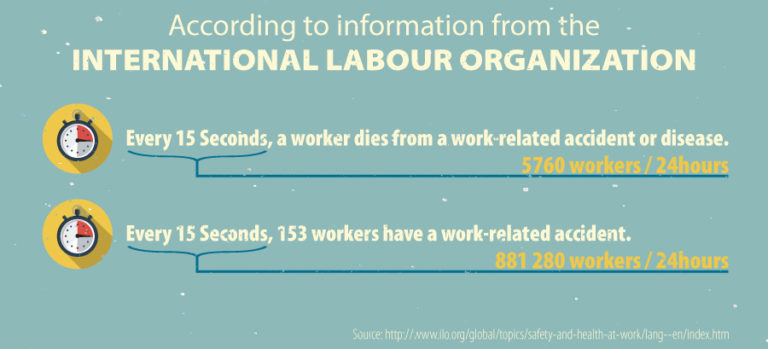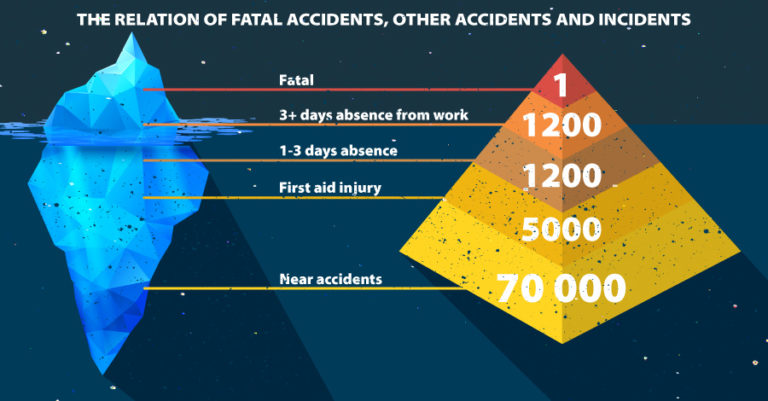Occupational Injuries: Regulations, Notification and Costs
 International Labour Organization
International Labour Organization
About 374 million occupational accidents occur annually; many of these resulting in long absences from work. Even if the data are not very accurate on the national level, it is clear that in many countries the problem requires more decisive action from the public authorities.
Definitions
Occupational injuries are defined as any personal injury, disease or death resulting from an occupational accident. An occupational injury is therefore distinct from an occupational disease, which is a disease contracted as a result of an exposure over a period of time to risk factors arising from work activity.
An occupational accident is an unexpected and unplanned occurrence, including acts of violence, arising out of or in connection with work. Occupational accidents also include travel, transport or road traffic accidents in which workers are injured and which arise out of or in the course of work, i.e. while engaged in an economic activity, or at work, or carrying on the business of the employer.
Relevant laws and regulations
National laws or regulations on Occupational Health and Safety in many countries provide for:
- the reporting of occupational accidents and diseases to the appropriate authority within a prescribed time
- standard procedures for reporting and investigating fatal and serious accidents, as well as dangerous occurrences
- the compilation and publication of statistics on accidents, occupational diseases and dangerous occurrences.
ILO has established a Global Database on Occupational Safety and Health Legislation; LEGOSH Occupational Safety and Health (OSH) in which you can browse this legalization by country;
“One example; Tanzania;”“Occupational Health and Safety Act, 2003 (No. 5). (§ 90(1)(d));“
Employers are required to keep a register describing, inter alia, the occupational accidents and cases of occupational disease occurring at the factory or workplace in which notice was required to be sent to the Chief Inspector.Occupational Health and Safety Act, 2003 (No. 5). (§§ 101(1)(a),(c);90(1)(d),(2));
Employers have a duty to notify the Chief Inspector about each incident occurring at the workplace where any person dies, becomes unconscious, suffers the loss of a limb or part of a limb, or is otherwise injured or becomes ill from occupational disease to such a degree that he or she is likely either to die or suffer a permanent physical defect or is likely to be unable either to work or to continue with the activity for which he or she was employed or is usually employed for a period of a least fourteen days (§ 101(1)(a)).Employers are obliged to also report near misses to the Chief Inspector. Such near misses include incidents where the health or safety of any person was endangered and where a dangerous substance was spilled (§ 101(1)(c).Employers are required to keep a register describing, inter alia, the occupational diseases occurring in the workplace in which notice was required to be sent to the Chief inspector. The owner of a factory or workplace is responsible for submitting such extracts from the register to an inspector as they may require for the purpose of executing his or her duties under the OHS Act (§ 90(1)(d),(2)).”
Notification of occupational injuries
One of the tasks of the competent authority is to ensure the establishment and application of procedures for the notification of occupational accidents and diseases by employers and, when appropriate, insurance institutions and others directly concerned, as well as the production of annual statistics on occupational accidents and diseases. (Alli, Fundamental principles of occupational health and safety, WHO, 2008).
Countries could use the ILO code of practice Recording and notification of occupational accidents and diseases (1995) as a basis for developing their own systems. An example of a recording form can be found in the ILO Encyclopedia.
Workers’ compensation schemes operated by ministries of labour have lists of the occupational injuries for which compensation may be claimed.
Whatever the system developed, it is the responsibility of the employer to present a detailed report to the authorities within a fixed period of any accident or disease outbreak that results in a specified amount of lost working time (in many countries, three or four days). After a major accident, for example, the employer must submit a report containing an analysis of the causes of the accident and describing its immediate on-site consequences, as well as indicating any action taken to mitigate its effects.
The employer, workers and workers’ representatives should be informed that notification has been carried out. Specifically, the labour inspectorate, where it exists, should be notified of industrial accidents and occupational diseases when they occur in the manner prescribed by national laws and regulations. It is equally the responsibility of the employer to keep records of relevant occupational accidents and diseases.
Pointing out that fatal accidents are just the tip of the iceberg, ILO uses an accident pyramid to illustrate that 500-2,000 less serious injuries take place for each fatality depending on the type of job. The relationship of fatal accidents to estimates of non-fatal accidents and other measures of risk is shown in the figure below.
 The pyramid illustrates the relation between fatal injuries, less serious injuries and near accidents. The iceberg illustrates that the number of fatal injuries is just the tip of the iceberg and that there are larger numbers of less serious injuries that take place without there being official notification
The pyramid illustrates the relation between fatal injuries, less serious injuries and near accidents. The iceberg illustrates that the number of fatal injuries is just the tip of the iceberg and that there are larger numbers of less serious injuries that take place without there being official notification
Injury frequency rates are generally calculated as the number of new cases of injury during the calendar year divided by the total number of hours worked by workers in the reference group during the year, multiplied by 1,000,000.
Injury incidence rates are calculated as the number of new cases of injury during the calendar year divided by the number of workers in the reference group during the year, multiplied by 100,000. (ILO Training Package on Development of a National Programme of Occupational Safety and Health)
The cost of occupational injuries
Worldwide, hazardous conditions in the workplace were responsible for a minimum of 312,000 fatal unintentional occupational injuries. Together, fatal and non-fatal occupational injuries resulted in about 10.5 million Disability-Adjusted Life Years (DALYs); that is, about 3.5 years of healthy life are lost per 1,000 workers every year globally. Occupational risk factors are responsible for 8.8% of the global burden of mortality due to unintentional injuries and 8.1% of DALYs due to this outcome. (The Global Burden Due to Occupational Injury; Concha-Barrientos et.al., Am J Ind Med 48:470–481, 2005).
Economic costs of work-related injury and illness vary between 1.8 and 6.0% of GDP in country estimates, the average being 4% according to the ILO. (Global Estimates of the Burden of Injury and Illness at Work in 2012, Takala et.al., J Occup Envir Hyg, 11: 326–337, 2014).
The direct and indirect costs of work-related accidents and ill-health have been extensively researched and documented in recent years. This has clearly demonstrated the great economic burden that such accidents and ill-health place on individuals, enterprises, families and on society in general (Figure 1 in the link below).
Takala et.al., Journal of Occupational and Environmental Hygiene, 11: 326–337, 2014
Occupational accidents not only cause great pain, suffering and death to victims, but also to their dependants. Occupational accidents also result in:
- loss of skilled and unskilled but experienced labour
- material loss, i.e. damage to machinery and equipment as well as spoiled products
- costs of medical care, payment of compensation and repairing or replacing damaged machinery and equipment.
Share this
Occupational Health in Developing Countries

Occupational Health in Developing Countries


Reach your personal and professional goals
Unlock access to hundreds of expert online courses and degrees from top universities and educators to gain accredited qualifications and professional CV-building certificates.
Join over 18 million learners to launch, switch or build upon your career, all at your own pace, across a wide range of topic areas.
Register to receive updates
-
Create an account to receive our newsletter, course recommendations and promotions.
Register for free







